Furniture in Public Collections in Canada / La Collection Nationale de Mobilier
New Brunswick Museum
1 There are over four hundred pieces of furniture in the New Brunswick Museum. Ever since the collections of the Mechanics Institute and those of Abraham Gesner were amalgamated in 1842 to form the museum, there has been an on-and-off effort to add to the furniture collection.
2 Many of the pieces are of New Brunswick manufacture, most of them from the second half of the nineteenth century. There are also a number of Items which were brought to the province by some of the more than 14,000 Loyalists who crowded into the area at the end of the American Revolutionary war. These people all came by ship and were able to bring anything from hand luggage to entire shiploads of their own goods. Indeed, in some cases they returned to their former homes and brought extra shiploads of furniture and other necessities. Thus the museum has examples of the work of colonial American furniture makers. A fine flat-topped New England tallboy brought to New Brunswick by Dr. John Calef is of superior workmanship. In contrast is the rough pine desk (fig. 1) made for Gabriel Ludlow, who became Saint John's first mayor. A slope-front desk (fig. 2), exhibiting the work of a careful craftsman, was brought to Maugerville on the St. John River from Massachusetts by Moses Pickard in 1762. It retains its original hardware and is in good condition.
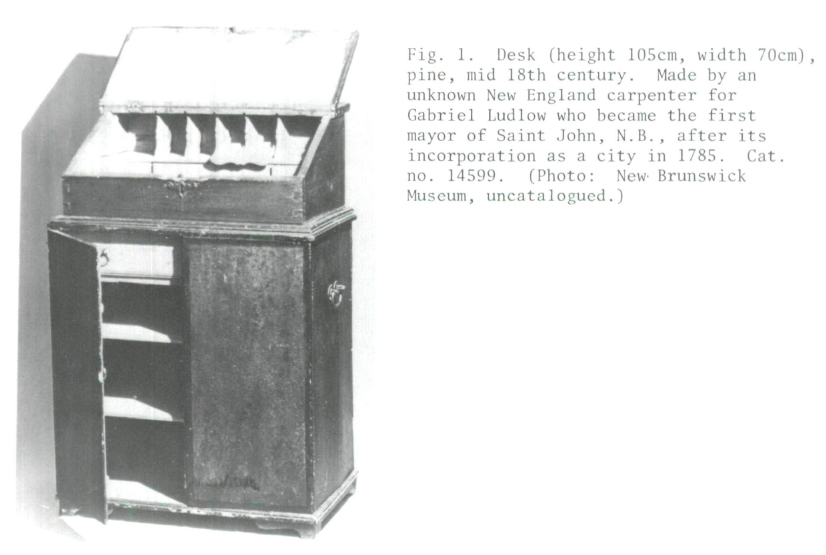 Display large image of Figure 1
Display large image of Figure 1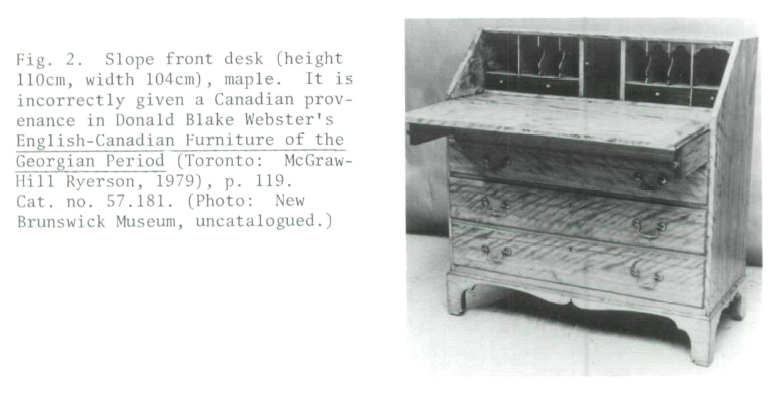 Display large image of Figure 2
Display large image of Figure 23 Early in the nineteenth century a group of trained craftsmen, mainly from Scotland, set up shops in Saint John and produced some of the finest furniture made in Canada. A fuller description of the work of some of these British-trained craftsmen is given in several publications, among them Donald Blake Webster, English-Canadian Furniture of the Georgian Period (Toronto: McGraw-Hill Ryerson, 1979); A. Gregg Finley, Heritage Furniture (Saint John, N.B.: New Brunswick Museum, 1976); Charles H. Foss, Cabinetmakers of the Eastern Seaboard (Toronto: M.F. Feheley, 1977); Huia G. Ryder, Antique Furniture by New Brunswick Craftsmen (Toronto: Ryerson Press, 1965). The products of two of these craftsmen, Thomas Nisbet and Alexander Lawrence, are found in several important museum collections in Canada. A small work table bearing Nisbet's label is shown in figure 3. It is made of native woods, an exception rather than the rule for Saint John-made furniture of the time. Nisbet's son Robert made the desk shown in figure 4 for the chamber of the Legislative Council, New Brunswick's upper house prior to Confederation. Robert Green, an English cabinetmaker who worked Ln New Brunswick from 1815 until his death ca. 1850, also produced exceptional work. A fine banquet table bearing his label has recently been added to the collection (see fig. 5.)
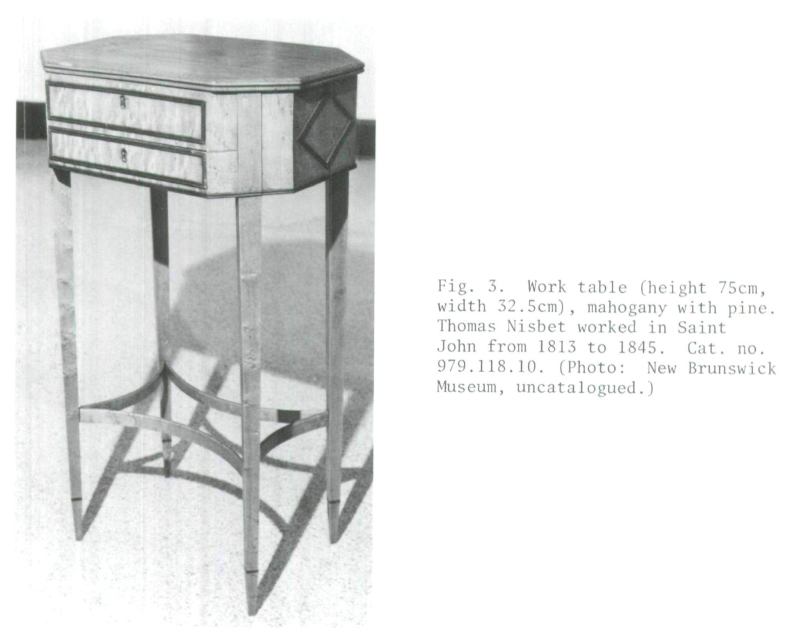 Display large image of Figure 3
Display large image of Figure 3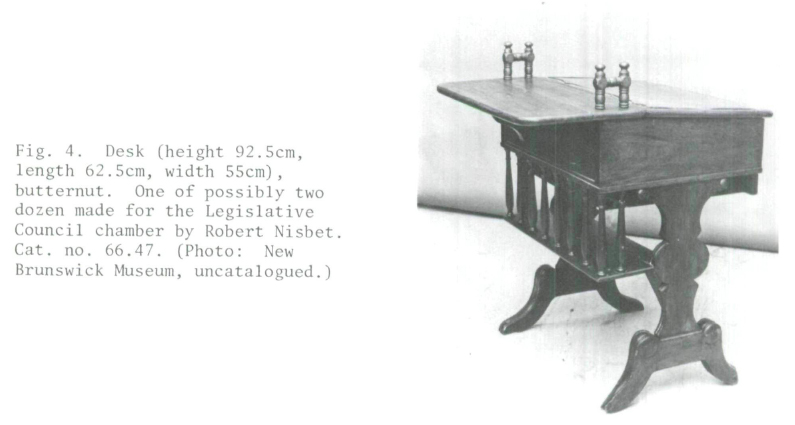 Display large image of Figure 4
Display large image of Figure 4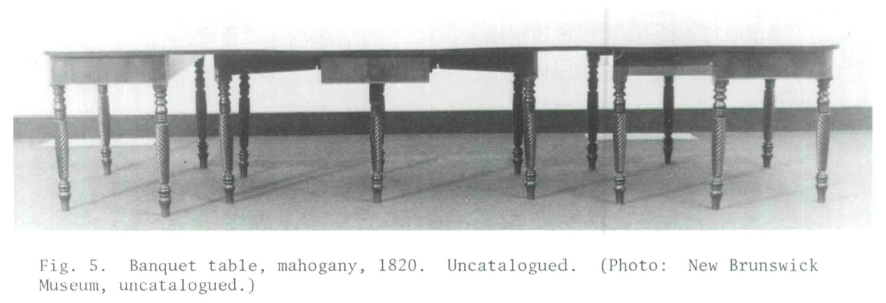 Display large image of Figure 5
Display large image of Figure 54 The museum has a wide selection of more than 200 chairs, the earliest one of oak from mediaeval England. There are many examples from colonial New England — ladder backs, fancy chairs, side chairs, wing backs, and others. One chair (see fig. 6) in the collection was once the property of Benedict Arnold and was disposed of at auction in 1792 at the time of his return to England. A fine, leather-covered wing chair, once the property of Admiral Edward William Owen of Campobello Island, is fitted with a gout stool (see fig. 7), The chair is figure 8, the work of John Rogerson, a distinguished Saint John woodcarver, was made for the local St. Andrews Society in 1908 and is still used every 30 November at the society's annual banquet.
5 Mahogany, which came from the West Indies as ballast on trading ships in the first half of the nineteenth century and earlier, was the most common wood used in furniture made in New Brunswick. The use of other woods for fine furniture at this period is rare and seems to appear in outlying areas rather than in the coastal trading communities. A fine example is a seven-drawer chest with applewood veneer fronts on the drawers and maple banding and butternut top and sides (fig. 9). It is attributed to the Truemans, a distinguished family of cabinetmakers from the Sackville area.
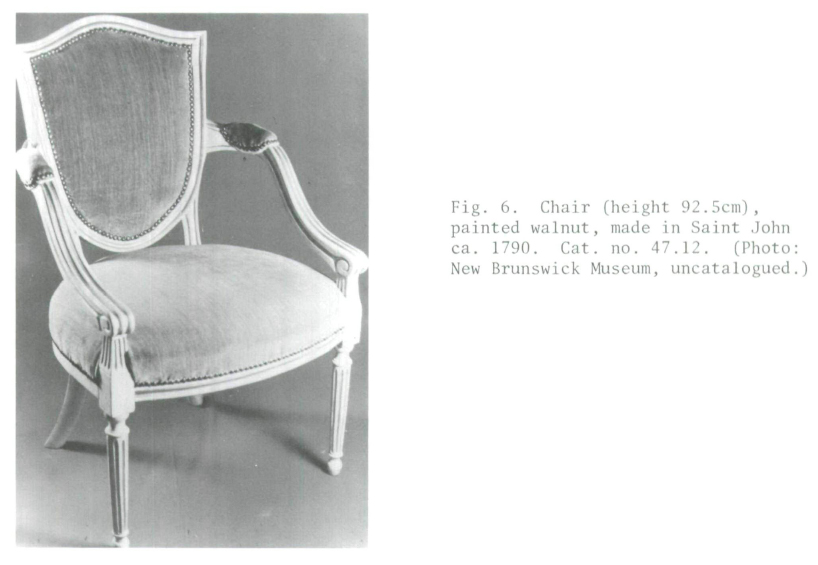 Display large image of Figure 6
Display large image of Figure 6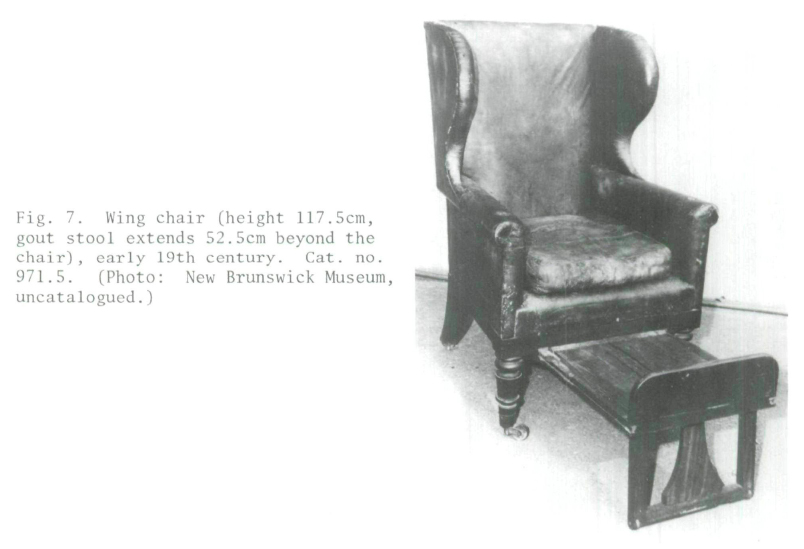 Display large image of Figure 7
Display large image of Figure 7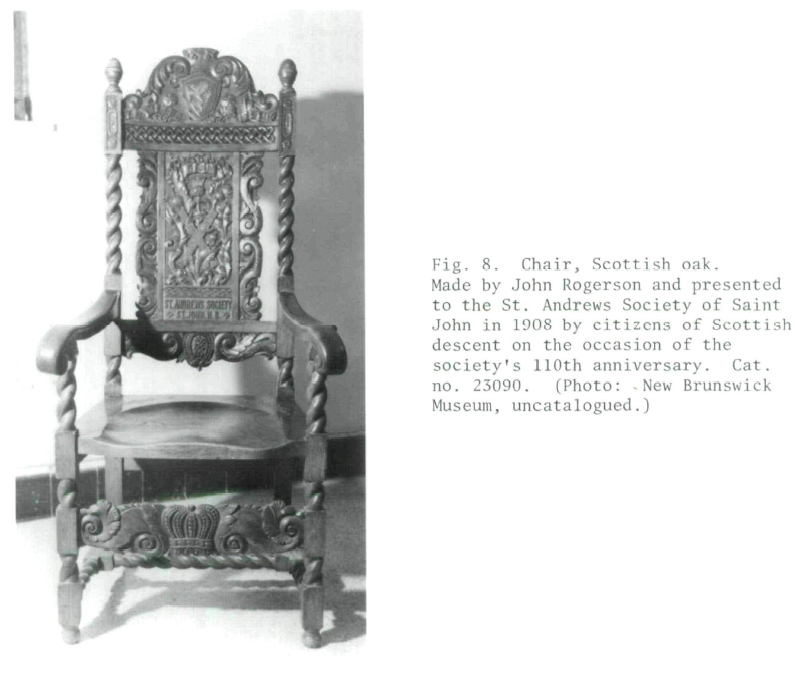 Display large image of Figure 8
Display large image of Figure 8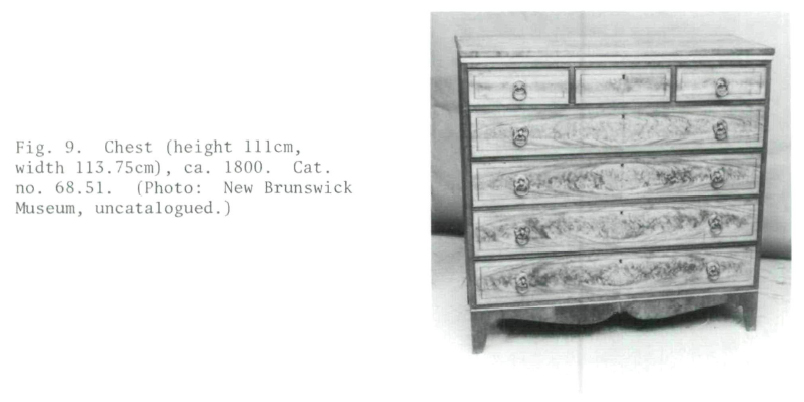 Display large image of Figure 9
Display large image of Figure 96 There are a score or more clocks. Of particular interest is a fine dwarf tall case clock, dating from 1830, made by a distinguished clockmaker and jeweller who worked in Saint John for half a century. The case is mahogany veneer on pine, while the face is brass and carries the inscription "James G. Melick, Saint John, N.B." Another, the work of James Agnew who was active in Saint John from 1834 to 1850, is shown in figure 10. An angelica, the unusual musical instrument shown in figure 11, is housed in a finely crafted rosewood cabinet on a pedestal. It contains twenty-five tuned tumblers with a range of more than two octaves.
7 The museum's collection, begun 150 years ago, is still being added to as appropriate pieces are brought to our attention. Examples of the work of contemporary cabinetmakers, such as Alban S. Emery who has worked in Saint John for seventy years, are also being acquired. In 1978 the New Brunswick Museum and the National Museum of Man collaborated to acquire a mahogany desk which was made by Emery and which had belonged to the late Senator Clarence V. Emerson of Saint John.
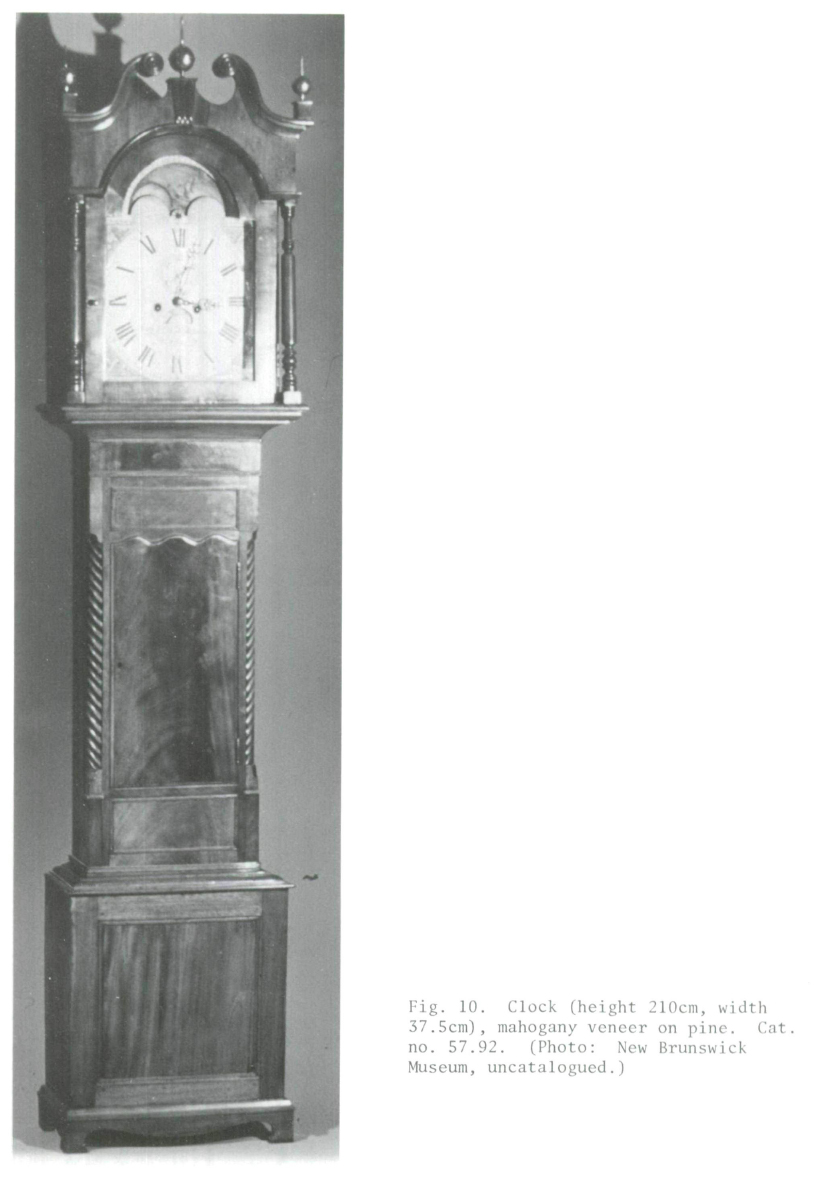 Display large image of Figure 10
Display large image of Figure 10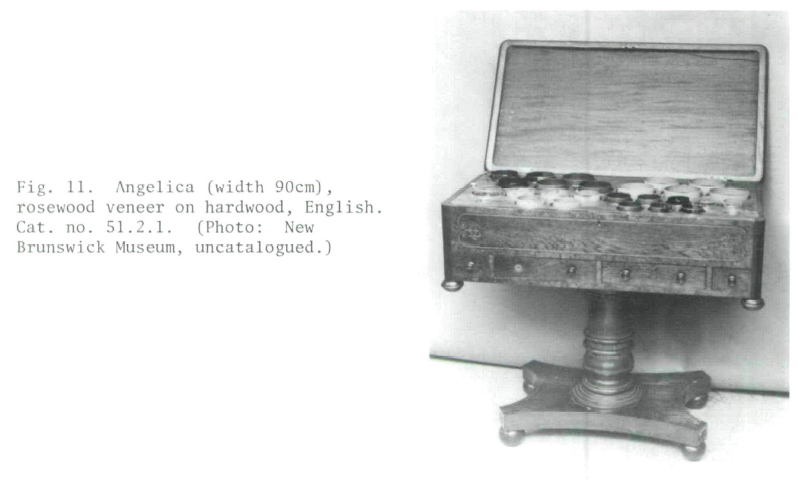 Display large image of Figure 11
Display large image of Figure 11